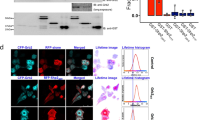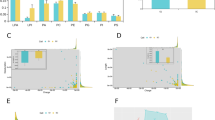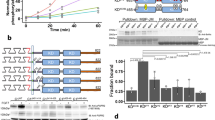Abstract
The receptor for epidermal growth factor (EGF) is a 170,000–180,000 molecular weight single-chain glycoprotein of 1,186 amino acids1. Its sequence suggests that it has an external EGF-binding domain, formed by the NH2-terminal 621 amino acids, linked to a cytoplasmic region by a single membrane-spanning segment1. In the cytoplasmic portion, starting 50 residues from the membrane, there is a 250-residue stretch similar to the catalytic domain of the src gene family of retroviral tyrosine protein kinases1, and, indeed, a tyrosine-specific protein kinase activity intrinsic to the receptor is stimulated when EGF is bound2–5. Increased tyrosine phosphorylation of cellular proteins, detected in A431 cells following EGF binding6,7, may be important in the mitogenic signal pathway. Tumour promoters such as 12-O-tetradecanoyl-phorbol-13-acetate (TPA), counteract this increase8,9, as well as causing loss of a high affinity class of EGF binding sites9. The major receptor for TPA has been identified as the serine/threonine-specific Ca2+/phospholipid-dependent diacylglycerol-activated protein kinase, protein kinase C10–14. By substituting for diacylglycerol, TPA stimulates protein kinase C. Protein kinase C phosphorylates purified EGF receptor at specific sites, and this reduces EGF-stimulated tyrosine protein kinase activity8. TPA treatment of A431 cells increases serine and threonine phosphorylation of the EGF receptor at the same sites8,15, which suggests that the reduction of EGF receptor kinase activity in TPA-treated cells is a consequence of the receptor's phosphorylation by the kinase. We have attempted to identify these phosphorylation sites and show here that protein kinase C phosphorylates threonine 654 in the human EGF receptor. This threonine is in a very basic sequence nine residues from the cytoplasmic face of the plasma membrane in the region before the protein kinase domain; it is thus in a position to modulate signalling between this internal domain and the external EGF-binding domain.
This is a preview of subscription content, access via your institution
Access options
Subscribe to this journal
Receive 51 print issues and online access
$199.00 per year
only $3.90 per issue
Buy this article
- Purchase on Springer Link
- Instant access to full article PDF
Prices may be subject to local taxes which are calculated during checkout
Similar content being viewed by others
References
Ullrich, A. et al. Nature 309, 418–425 (1984).
Cohen, S., Carpenter, G. & King, L. E. J. biol. Chem. 255, 4834–4842 (1980).
Ushiro, H. & Cohen, S. J. biol. Chem. 255, 8363–8365 (1980).
Buhrow, S. A., Cohen, S. & Staros, J. V. J. biol. Chem. 257, 4019–4022 (1981).
Cohen, S. et al. J. biol. Chem. 257, 1523–1531 (1982).
Hunter, T. & Cooper, J. A. Cell 24, 741–752 (1981).
Gill, G. N. & Lazar, C. S. Nature 293, 305–307 (1981).
Cochet, C. et al. J. biol. Chem. 259, 2553–2558 (1984).
Friedman, B. et al. Proc. natn. Acad. Sci. U.S.A. 81, 3034–3038 (1984).
Niedel, J. E., Kuhn, L. J. & Vandenbark, G. R. Proc. natn. Acad. Sci. U.S.A. 80, 36–40 (1983).
Castagna, M. et al. J. biol. Chem. 257, 7847–7851 (1982).
Leach, K. L., James, M. L. & Blumberg, P. M. Proc. natn. Acad. Sci. U.S.A. 80, 4208–4212 (1983).
Ashendel, C. L., Staller, J. M. & Boutwell, R. K. Biochem. biophys. Res. Commun. 111, 340–345 (1983).
Parker, P., Stabel, S. & Waterfield, M. D. EMBO J. 3, 953–959 (1984).
Iwashita, S. & Fox, C. F. J. biol. Chem. 259, 2559–2567 (1984).
Downward, J. et al. Nature 307, 521–527 (1984).
Yamamoto, T. et al. Cell 35, 71–78 (1983).
Nishizuka, Y. et al. Adv. cyclic Nucleotide Res. 9, 209–220 (1978).
Takai, Y. et al. J. biol. Chem. 254, 3692–3695 (1979).
Wise, B. C. et al. J. biol. Chem. 257, 8489–8495 (1982).
Ramachandran, C. et al. J. biol. Chem. (in the press).
Turner, R. S. et al. J. Neurochem. (in the press).
Sano, K. et al. J. biol. Chem. 258, 2010–2013 (1983).
Sawyer, S. T. & Cohen, S. Biochemistry 20, 6280–6286 (1981).
Kraft, A. S. & Anderson, W. B. Nature 301, 621–623 (1983).
Lee, L.-S. & Weinstein, I. B. Science 202, 313–315 (1978).
Shoyab, M., DeLarco, J. E. & Todaro, G. J. Nature 279, 387–391 (1979).
Salomon, D. S. J. biol. Chem. 256, 7958–7966 (1981).
King, A. C. & Cuatrecasas, P. J. biol. Chem. 257, 3053–3060 (1982).
Hunter, T. & Sefton, B. M. Proc. natn. Acad. Sci. U.S.A. 77, 1311–1315 (1980).
Kikkawa, U. et al. J. biol. Chem. 257, 13341–13348 (1982).
Author information
Authors and Affiliations
Rights and permissions
About this article
Cite this article
Hunter, T., Ling, N. & Cooper, J. Protein kinase C phosphorylation of the EGF receptor at a threonine residue close to the cytoplasmic face of the plasma membrane. Nature 311, 480–483 (1984). https://doi.org/10.1038/311480a0
Received:
Accepted:
Issue Date:
DOI: https://doi.org/10.1038/311480a0
This article is cited by
-
PKCδ-mediated SGLT1 upregulation confers the acquired resistance of NSCLC to EGFR TKIs
Oncogene (2021)
-
A PKC-SHP1 signaling axis desensitizes Fcγ receptor signaling by reducing the tyrosine phosphorylation of CBL and regulates FcγR mediated phagocytosis
BMC Immunology (2014)
-
Annexin A6 is a scaffold for PKCα to promote EGFR inactivation
Oncogene (2013)
-
Simultaneous visualization of the extracellular and cytoplasmic domains of the epidermal growth factor receptor
Nature Structural & Molecular Biology (2011)
-
Fifty-gigahertz Microwave Exposure Effect of Radiations on Rat Brain
Applied Biochemistry and Biotechnology (2009)
Comments
By submitting a comment you agree to abide by our Terms and Community Guidelines. If you find something abusive or that does not comply with our terms or guidelines please flag it as inappropriate.



